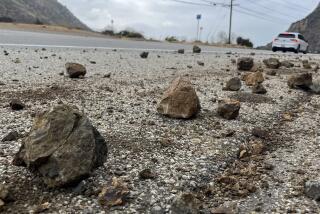Volcanoes : Eruption Roulette : Researchers Face the Fallout When Their Dire Eruption Warnings Don’t Pan Out
- Share via
When La Soufriere volcano on the Caribbean island of Guadeloupe stirred to life in 1976, it started a fractious dispute among French volcanologists over how serious an eruption might occur.
The most alarmed scientists prevailed, and the capital of Basse-Terre was evacuated. But after four months away from their homes and no big eruption, the people were allowed to move back.
Twenty years later, that big eruption has yet to occur.
Now, the Guadeloupe experience may be repeated at giant Popocatepetl volcano near Mexico City and at the Soufriere Hills volcano on the tiny Caribbean island of Montserrat.
In both places, eruptions of ash and steam, and the building of lava domes, have gone on for months, amid warnings by some scientists that truly catastrophic eruptions are possible.
But so far nothing catastrophic has happened, and the uncertainty is straining the patience of both scientists and government authorities, breeding occasional tension between them.
At Popocatepetl, the director of the Mexican Center for Disaster Prevention, Roberto Meli, recently called a well-known American volcanologist, Stanley Williams of Arizona State University, “irresponsible” for saying the 17,887-foot peak may soon enter a dangerously explosive phase.
Williams, back from monitoring gas emissions at “Popo,” was not contrite.
“What am I guilty of?” he asked in May. “When the volcano is turned on and begins to act, as this one is, that’s when we should start to speak out, educating people as to the dangers, so they will be able to take precautions.”
A month later, however, Williams had to acknowledge that Popocatepetl had entered a quieter stage.
A similar dispute at Montserrat has been even more protracted and has involved much costlier and longer evacuations.
There, a team of scientists from the U.S. Geological Survey last year advised the evacuation of the island capital of Plymouth, right next to the volcano, although a Trinidad scientist in charge of the monitoring was, at first, dubious.
Three evacuations were eventually ordered, and the final one, which began in April, lasted for months. While some urged that the entire island be emptied, residents were required only to go to the other end of the island.
As weeks went by without a major eruption, some residents began sneaking back into town. Finally, in mid-July, authorities called off part of the evacuation. Chief Minister Reuben Meade explained that scientists had changed their minds and now believed that “the explosive potential of the volcano is minimal.”
Impatience with evacuations is common, even when dangers seem quite evident.
In 1980 at the Mt. St. Helens volcano in Washington, despite bulges of six feet a day on the volcano’s slope overlooking the resort area of Spirit Lake, homeowners demanded the right to go in and retrieve their belongings.
The authorities acceded to the request. On May 17, 1980, they escorted some of them in for the day. The next morning another caravan was ready to enter the evacuation zone but was stopped when the top of the mountain exploded and an avalanche of superheated material swept into Spirit Lake, burying and killing every living thing there.
Based on clues such as seismicity, ground deformation and sulfur dioxide and carbon dioxide emissions, researchers have made considerable progress in predicting--a short time before--when an eruption will occur. Scientists have even learned to recognize the seismic quiet that sometimes precedes the final stages before an explosion.
What they usually can’t say is how big the eruption will be. And, while recognizing precursory signs of unrest, they can’t tell with precision very far in advance when eruptions will begin. When accurate warnings were issued, they usually came hours or days, not weeks, before.
At the Long Valley caldera near Mammoth Lakes, the U.S. Geological Survey has been monitoring seismicity closely for 16 years and studying gas emissions since the early 1990s. But seismologist David Hill acknowledges that it remains uncertain whether an eruption will occur next year, or in the next 100 years, or later.
Asked recently by the Mammoth Lakes Times to give “the realistic odds of a life-threatening and property-damaging volcanic event occurring within the next 50 years in Mammoth Lakes,” Hill would say only that the odds of anything happening in a given year are “one in a few hundred.”
Yet he has also indicated--as repeated earthquake swarms and continuing carbon dioxide emissions occurred this spring and summer--that he would interpret any indication of ground deformation as a sign of imminent danger if combined with seismic events and gas emissions.
Ground deformation has often been the last signal before an eruption.
On the South Pacific island of Rabaul, eruptions in 1994 were preceded by a measured rise in ground levels just four days beforehand. Then an overnight rise of about 20 feet along the shoreline became evident at dawn on the day of the eruptions.
In fact, two mountains on opposite sides of the entrance of Rabaul harbor began erupting just minutes after first light revealed the huge rise along the shoreline. But there had been enough precursory signs to begin an evacuation late the previous afternoon.
Rabaul had sustained hundreds of deaths in an eruption in 1937, so monitoring was extensive and the public was willing to evacuate when signals were given.
But scientists on Rabaul had the advantage of events marching rapidly to a conclusion. At Popocatepetl, on the island of Montserrat and at Mammoth Lakes, there has been no such rapid denouement.
More to Read
Sign up for Essential California
The most important California stories and recommendations in your inbox every morning.
You may occasionally receive promotional content from the Los Angeles Times.










